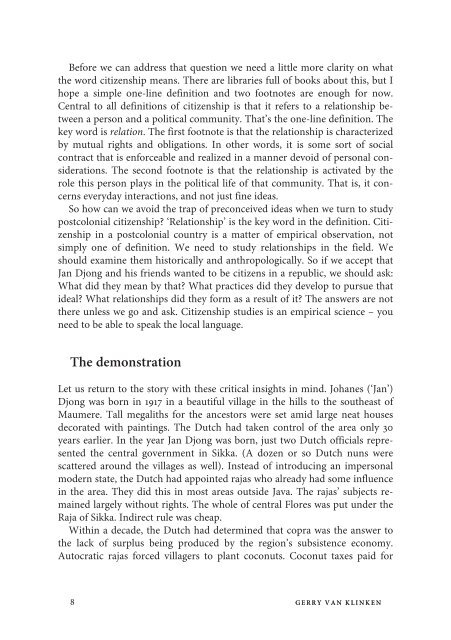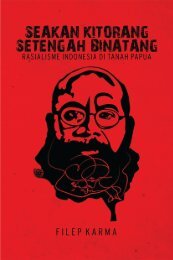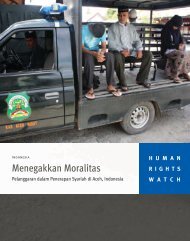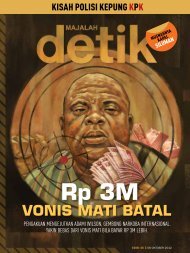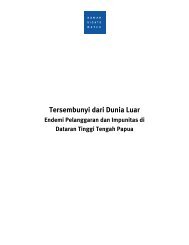Postcolonial Citizenship
PDF-6104Weboratie_Van_Klinken_-_DEF
PDF-6104Weboratie_Van_Klinken_-_DEF
Create successful ePaper yourself
Turn your PDF publications into a flip-book with our unique Google optimized e-Paper software.
Before we can address that question we need a little more clarity on what<br />
the word citizenship means. There are libraries full of books about this, but I<br />
hope a simple one-line definition and two footnotes are enough for now.<br />
Central to all definitions of citizenship is that it refers to a relationship between<br />
a person and a political community. That’s the one-line definition. The<br />
key word is relation. The first footnote is that the relationship is characterized<br />
by mutual rights and obligations. In other words, it is some sort of social<br />
contract that is enforceable and realized in a manner devoid of personal considerations.<br />
The second footnote is that the relationship is activated by the<br />
role this person plays in the political life of that community. That is, it concerns<br />
everyday interactions, and not just fine ideas.<br />
So how can we avoid the trap of preconceived ideas when we turn to study<br />
postcolonial citizenship? ‘Relationship’ is the key word in the definition. <strong>Citizenship</strong><br />
in a postcolonial country is a matter of empirical observation, not<br />
simply one of definition. We need to study relationships in the field. We<br />
should examine them historically and anthropologically. So if we accept that<br />
Jan Djong and his friends wanted to be citizens in a republic, we should ask:<br />
What did they mean by that? What practices did they develop to pursue that<br />
ideal? What relationships did they form as a result of it? The answers are not<br />
there unless we go and ask. <strong>Citizenship</strong> studies is an empirical science – you<br />
need to be able to speak the local language.<br />
The demonstration<br />
Let us return to the story with these critical insights in mind. Johanes (‘Jan’)<br />
Djong was born in 1917 in a beautiful village in the hills to the southeast of<br />
Maumere. Tall megaliths for the ancestors were set amid large neat houses<br />
decorated with paintings. The Dutch had taken control of the area only 30<br />
years earlier. In the year Jan Djong was born, just two Dutch officials represented<br />
the central government in Sikka. (A dozen or so Dutch nuns were<br />
scattered around the villages as well). Instead of introducing an impersonal<br />
modern state, the Dutch had appointed rajas who already had some influence<br />
in the area. They did this in most areas outside Java. The rajas’ subjects remained<br />
largely without rights. The whole of central Flores was put under the<br />
Raja of Sikka. Indirect rule was cheap.<br />
Within a decade, the Dutch had determined that copra was the answer to<br />
the lack of surplus being produced by the region’s subsistence economy.<br />
Autocratic rajas forced villagers to plant coconuts. Coconut taxes paid for<br />
8 GERRYVANKLINKEN


